After working in the office all day, we all know our condition. We experience neck, shoulders, wrists, back, lower back, and knee pain, accompanied by stiffness and discomfort everywhere. These are common issues due to prolonged sitting and poor posture.
However, if we regularly incorporate some simple exercises, we can significantly minimise this pain. Even during office hours, taking a few minutes for these exercises can make a significant difference.
Desk Exercises to Alleviate Discomfort
The exercises I’m going to share are specifically designed for office workers. They can be done while sitting at your desk and will only take about 10 minutes. If you can spare that time, it’s great! Doing these exercises will make you feel much lighter and refreshed, giving you the energy to continue working with more focus.
Wrist Pain Relief Exercises
Wrist pain is a common complaint among office workers. Due to prolonged and repetitive use of the keyboard and mouse one is prone to developing carpal tunnel syndrome, a painful wrist condition1. So, it’s essential to perform some wrist exercises:
1) Wrist Flexion and Extension:
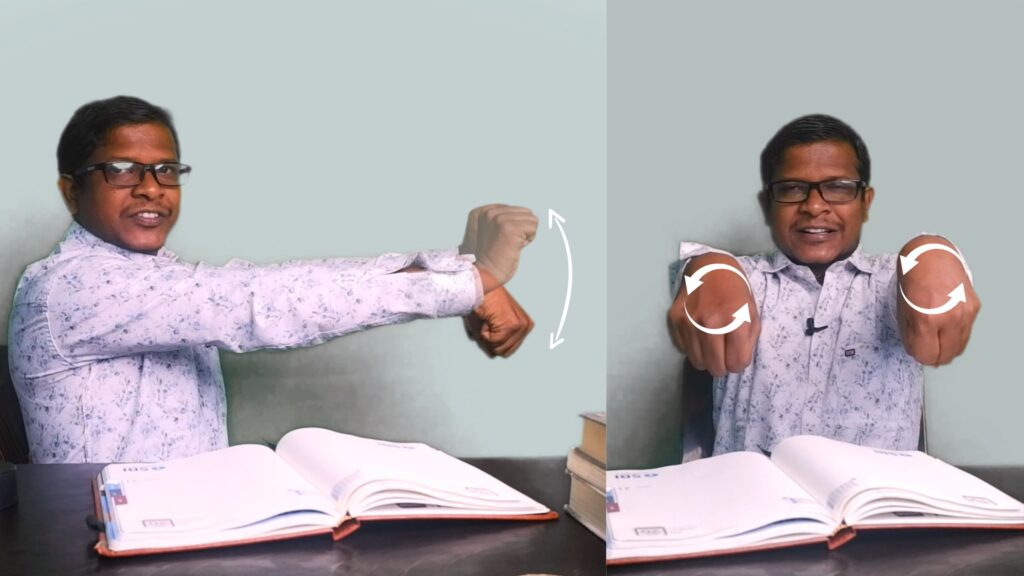
- To perform this exercise, start by extending your arm with your palm facing downwards.
- Then, gently move your wrist up towards the ceiling and down towards the floor in a controlled motion.
- Aim to maintain a steady and fluid movement.
- This exercise can help to improve flexibility and mobility in your wrist joint.
- Perform the movement gently and avoid any jerky or forceful motions.
2) Wrist Circumduction:
To perform the wrist circumduction exercise, follow these steps:
- Start by extending your arm in front of you, keeping it parallel to the ground.
- Rotate your wrist clockwise, moving your hand in a smooth circular motion.
- After a few rotations, switch to rotating your wrist counterclockwise, again moving your hand in a smooth circular motion.
- Repeat these motions for about 10-15 repetitions in each direction.
This exercise helps to maintain mobility in the wrist joint and can be beneficial for preventing stiffness and promoting flexibility.
3) Wrist Stretch:
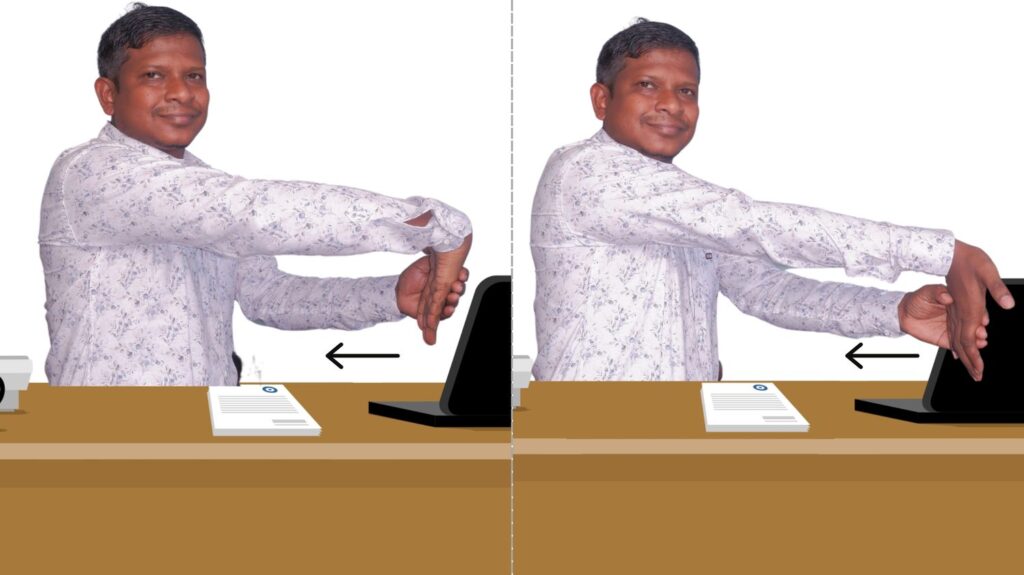
- Start by extending your arm in front of you with your palm facing down.
- Then, use your other hand to gently grab your fingers and pull them inward toward your body. You should feel a stretch in your wrist and forearm.
- Hold this position for about 30 seconds.
- After 30 seconds, release the stretch and relax for a moment.
- Next, rotate your palm so it is facing up.
- Repeat the stretch by gently pulling your fingers towards your body again. This will target slightly different muscles in your wrist and forearm.
- Hold for 30 seconds and then release.
4) Forearm Stretch for Pain Relief
Forearm pain is another common issue caused by extensive computer work. The stretching exercises mentioned above for the wrist can also be beneficial for the forearm:
- Keep your arm straight and stretch your wrist to feel a good stretch along your forearm.
- Perform this stretch on both sides to balance the muscles around the elbow and forearm.
These stretches are useful not only for wrist pain but also for conditions like Tennis elbow and Golfer’s elbow, which cause pain on the inside of the elbow.
Neck Pain Relief Exercises
Neck stiffness is a prevalent issue among office workers, affecting 10% to 62% of this population2 due to prolonged computer use, awkward postures, and physical inactivity. Addressing this problem through targeted neck exercises can help alleviate symptoms, improve musculoskeletal health, and even boost overall well-being.
Here are some exercises to alleviate neck pain:
5) Neck Side Bend
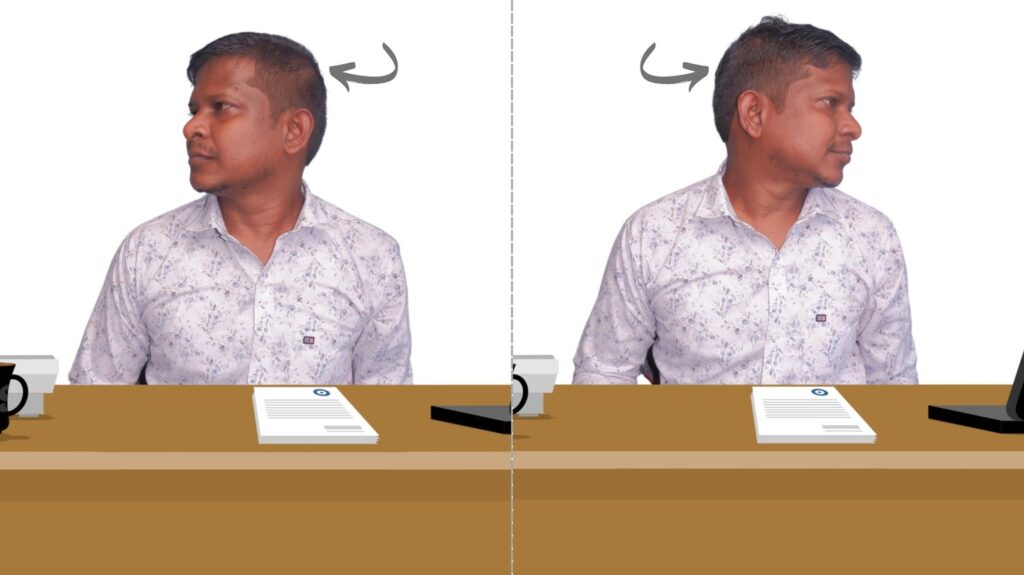
- Sit in a comfortable position with your back straight.
- Slowly tilt your head to the right, bringing your right ear towards your right shoulder until you feel a gentle stretch along the left side of your neck.
- Hold this position for about 15-30 seconds, feeling the stretch but not to the point of discomfort.
- Slowly return your head to the centre and repeat the same movement on the left side, bringing your left ear towards your left shoulder.
- Again, hold for 15-30 seconds. Repeat this stretch on both sides as needed to help alleviate tension in your neck.
6) Neck Rotation:
- Start by sitting or standing up straight with your shoulders relaxed.
- Gently tilt your head to the right, bringing your right ear towards your right shoulder.
- Hold this stretch for a few seconds.
- Then, slowly bring your head back to the centre and repeat the same movement on the left side, bringing your left ear towards your left shoulder.
- Repeat this side-to-side movement about 10-15 times, allowing your neck muscles to stretch and release tension.
- Remember to move smoothly and avoid any jerky movements. This exercise can help improve neck mobility and relieve stiffness.
7) Neck Stretch:

- To stretch the muscles on the side of your neck, start sitting or standing comfortably.
- Place your right hand over the left side of your head, just above your left ear.
- Gently tilt your head to the right, using the weight of your hand to increase the stretch until you feel a comfortable pull along the left side of your neck.
- Hold this position for about 30 seconds. Then, switch to the other side.
- Place your left hand over the right side of your head, just above your right ear, and gently tilt your head to the left, again using the weight of your hand to increase the stretch.
- Hold this position for about 30 seconds as well.
- This exercise can help relieve tension in the neck and improve flexibility.
Shoulder Pain Relief Exercises
Many office workers experience shoulder pain and stiffness due to sitting in the same position for long periods, straining their shoulders, and not moving enough23.
Regular physical exercise, including targeted shoulder exercises, strengthens shoulder and back muscles for better support and reduced risk of injury, improves flexibility and range of motion by preventing stiffness, and helps alleviate existing pain while preventing future discomfort4.
8) Shoulder Shrugs:

- Start by sitting up straight in a chair with your feet flat on the floor.
- Then, slowly lift your shoulders up toward your ears as high as you can.
- Hold this position for about 5-10 seconds, feeling the tension in your shoulders and upper back.
- Then, slowly relax and lower your shoulders back to the starting position.
- Repeat this exercise 3-5 times, and remember to breathe deeply and steadily as you perform the movement.
- This exercise can help to release tension and improve posture, however, there are effective exercises to improve the posture..
9) Shoulder Rolls:
To perform seated forward shoulder rotations as a desk exercise in a sitting position, start by:
- Sitting up straight in your chair with your feet flat on the floor.
- Place your hands on your thighs or on the armrests of your chair for support.
- Begin by slowly rotating your shoulders forward in a circular motion, making small circles at first.
- Gradually increase the size of the circles as you continue the motion.
- Aim to perform 10-15 rotations, focusing on maintaining proper posture and breathing rhythm throughout the exercise.
- This exercise effectively relieves tension and improves shoulder mobility, especially for those who spend extended periods sitting at a desk.
10) Cross-Arm Stretch
It is very common for computer workers to develop upper back pain. The cross-arm stretch I am going to share is very effective. However, if this pain is concerning you more, I would highly advise other effective upper back pain exercises to follow at home.

For this exercise, start sitting up straight on your office chair.
- Bring your left arm across your body until it is parallel to the ground.
- Use your right hand to hold your left elbow and gently pull it towards your right shoulder.
- Hold this position for 15-30 seconds while breathing deeply and feeling the stretch in the back of your left shoulder.
- Repeat the same steps with your right arm to stretch the back of the right shoulder.
This stretch targets the posterior deltoid and helps reduce stiffness in the shoulders. Remember to perform the stretch gently and avoid any jerky or forceful movements.
11) Self-Massage Technique Using a Tennis Ball
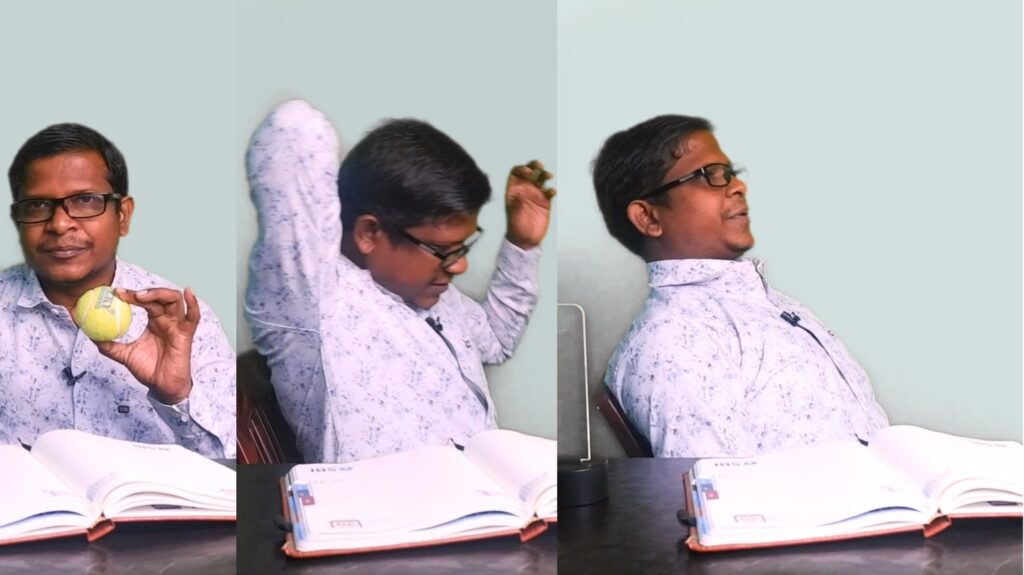
To use a tennis ball for managing back or upper back pain, follow these steps:
- Sit in a chair with a firm backrest.
- Take a tennis ball and place it between your back and the chair’s backrest at the location of the pain.
- Gently press your back against the ball and move your body to allow the ball to roll along the painful area.
- Apply as much pressure as feels comfortable, and focus on massaging the area by moving the ball in small circular motions.
- Continue this self-massage for a few minutes to help release tension and relieve the painful area.
12) Chair Push-Ups
To strengthen your upper body while seated, you can perform chair dips by following these steps:
- Sit in a sturdy chair with your back straight and feet flat on the floor.
- Place your hands on the edge of the chair, gripping the armrests if available, with your fingers pointing towards your feet.
- Slowly walk your feet forward so that your bottom is no longer on the edge of the seat but suspended in the air in front of the chair.
- Lower your body by bending your elbows and keeping your back close to the chair.
- Once your upper arms are parallel to the ground, straighten your arms and push yourself back up to the starting position.
This exercise primarily targets the triceps and shoulders and effectively builds upper body strength while seated.
13) Seated Leg Raises
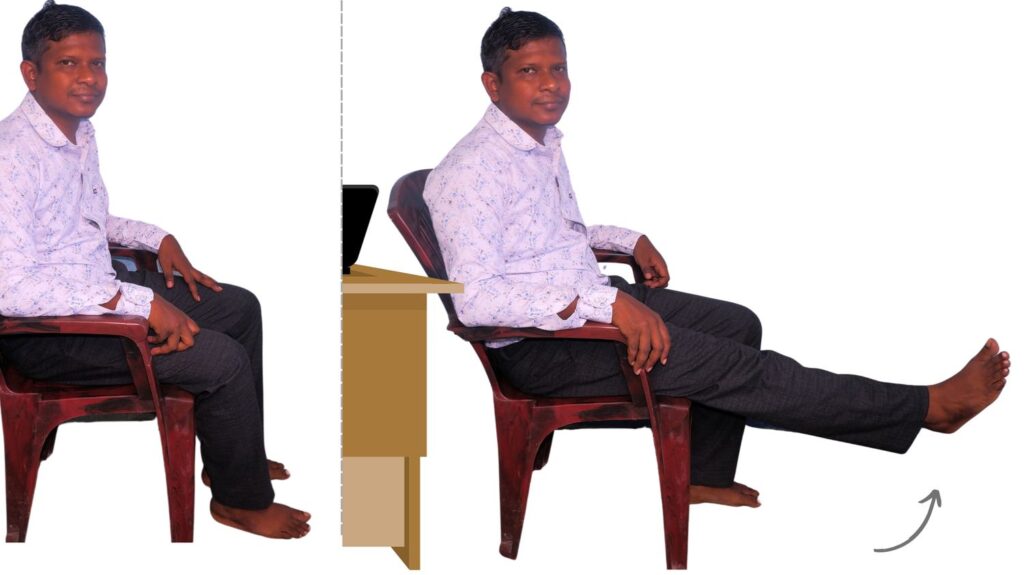
Sure! Here’s a more detailed explanation of the exercise:
- Sit on the edge of a chair with your back straight and feet flat on the floor.
- Straighten one leg out in front of you, keeping it parallel to the floor.
- Hold the position for a few seconds, then slowly lower your leg.
- Repeat the same movement with the other leg.
- Aim to do 10-15 repetitions for each leg.
This exercise helps strengthen the quadriceps and the large muscles at the front of the thigh and improves leg circulation. It’s a great way to work on leg strength and flexibility, especially if sitting for long periods.
14) Standing Trunk Rotation
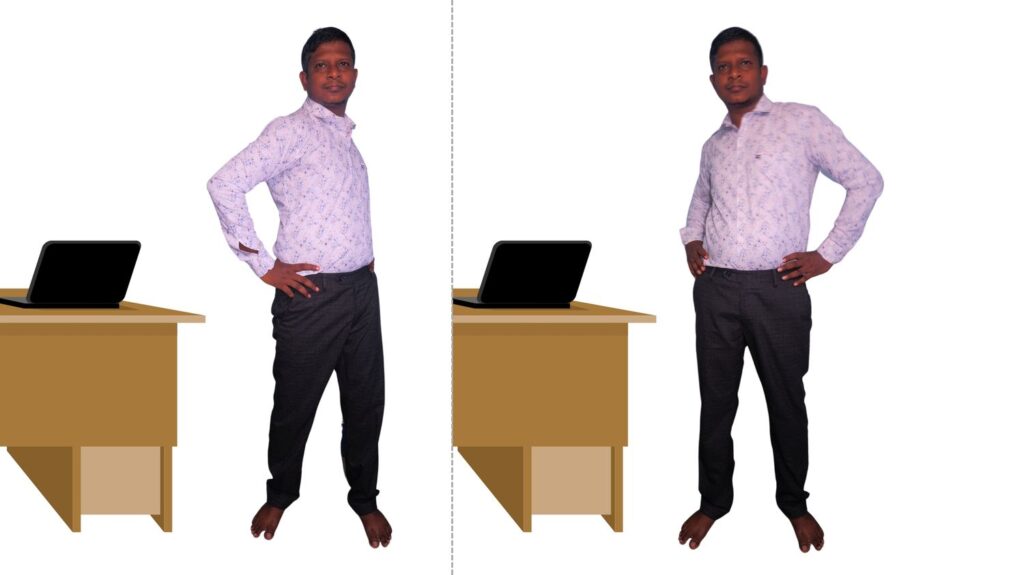
Prolonged sitting and awkward postures are major contributors to lower back pain3. While there are a number of good home exercises to alleviate lower back pain, here is an exercise that you can perform at your office.
To perform the side bend stretch:
- Start by standing up straight with your feet shoulder-width apart. Place your hands on your hips.
- Then, slowly bend your torso to one side without bending your knees. Keep your shoulders back and your chest open throughout the movement.
- Hold the stretch for 15-30 seconds, feeling the gentle pull along the side of your body.
- Return to the starting position and then repeat the stretch on the other side.
- It is an effective exercise for releasing tension in the lower back, stretching the side muscles, and improving overall flexibility.
15) Quadriceps Stretch
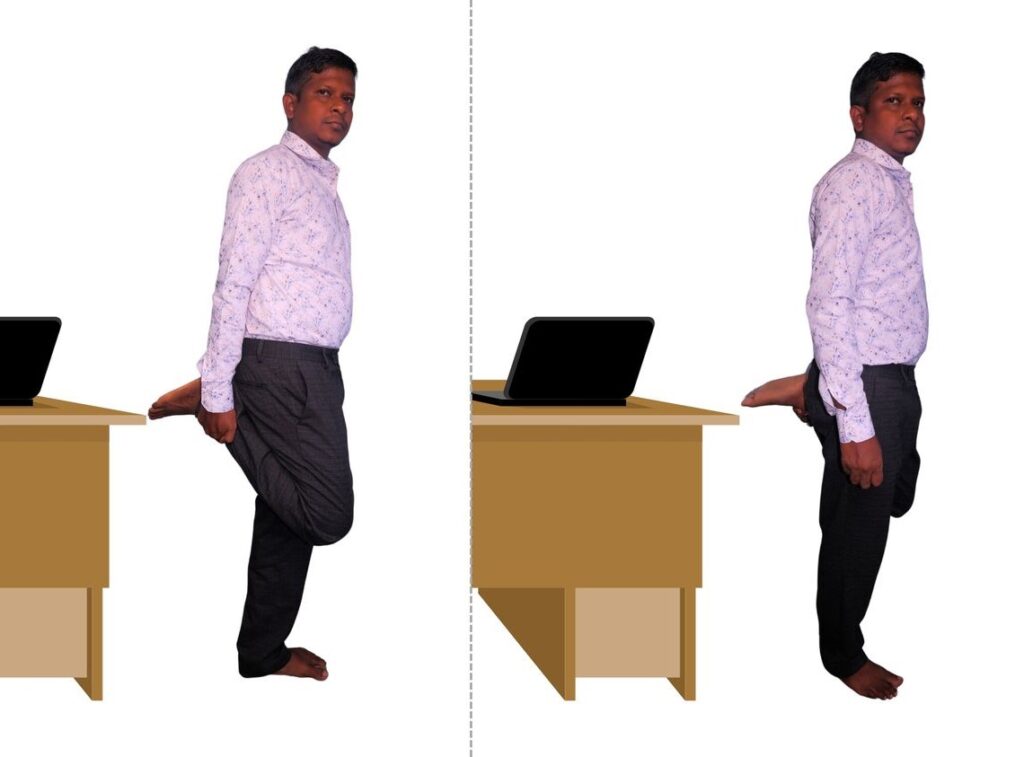
Stand up straight with your feet shoulder-width apart.
- While standing, bend your right knee and bring your foot towards your buttocks.
- Reach back with your right hand and hold onto the inside of your right ankle. Keep your knees together and your thighs aligned.
- Gently pull your ankle towards your buttocks until you feel a stretch in the front of your right thigh. Keep your hips squared and avoid arching your back.
- Hold this position for at least 10 seconds while maintaining steady breathing.
- After that, release your right ankle and return to the starting position. Then, repeat the same steps with your left leg.
Final Thoughts
These simple and effective office exercises help alleviate discomfort and improve your overall well-being. Take a short break every hour and perform few of these exercises, it will make you feel light and motivate to give your best at work.
In addition to this, I highly recommend you follow the perfect sitting position at the computer, as sitting awkwardly is the root cause of all issues.
Keep Reading: Desk Height Calculator for Better Ergonomics
The author is a physiotherapist who has been practising for the last 17 years. He holds a Bachelor's in Physiotherapy (BPT) from SVNIRTAR (Swami Vivekananda National Institute of Rehabilitation and Research), one of the prestigious physiotherapy schools in India.
Whatever he learns dealing with his patient, he shares it with the world through blogs and e-books. He also owns a YouTube channel, "Sunit Physiotherapist" with over 8 lakh active subscribers. Here, he shares everything he gets to learn serving the patient.





